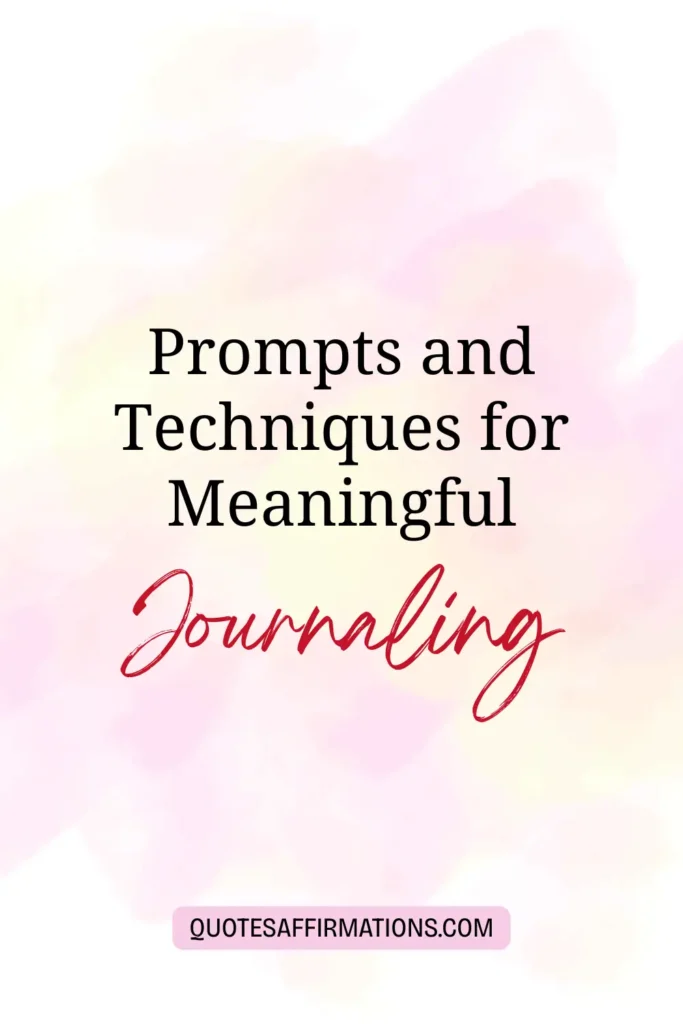Affirmation Journal: A Simple Tool to Strengthen Positive Thinking
Affirmation Journal: A Simple Tool to Strengthen Positive Thinking
An affirmation journal is a simple tool you can use every day to encourage a more positive mindset.
By writing down supportive statements about yourself, you remind yourself of your strengths and what you want to achieve.
This helps you build self-confidence and set clearer goals.
You really don’t need fancy supplies to get started. Grab a notebook or open a digital note—either works for jotting down daily affirmations or following prompts for inspiration.
Plenty of people find that keeping an affirmation journal over time supports personal growth and better self-esteem.
If you want ideas, free templates, or tips for writing effective positive statements, there are many resources to help you.
You might find useful prompts and examples from sites offering affirmation journals and guides, so you can create a routine that works for you.
What Is an Affirmation Journal?

Save what you love, hover or tap the image and pin it now.
An affirmation journal is designed to help you focus on positive self-talk and build new, healthy habits for your mindset.
Using daily prompts and simple routines, you can replace negative thoughts with supportive, realistic beliefs about yourself and your life.
Definition and Purpose
An affirmation journal is a notebook where you write down positive affirmations. These are short, simple statements about your strengths, abilities, or goals.
The main goal is to help you focus on personal growth by repeating these powerful messages each day.
Writing in an affirmations journal lets you challenge self-doubt and recognize your value. It encourages you to reflect on what you want to improve or believe about yourself.
Some people also include gratitude lists or use journal prompts to guide their writing. This makes the habit more engaging and gives you space to celebrate your progress.
Difference Between Affirmation and Traditional Journaling
Traditional journaling often involves writing about your day, thoughts, or feelings in an open format. It is personal and unstructured, letting you process events or emotions as they come.
An affirmation journal, by contrast, has a focused structure. You write and repeat positive affirmations, usually in the present tense.
The purpose is to shift negative thought patterns and support your confidence. A key difference is how you use the journal.
With an affirmation journal, you set intention and purpose around self-belief. The focus is on solutions rather than problems.
For some, combining the two practices can boost both self-awareness and positivity. To see how these differences play out, look at tips for making an affirmation journal.
Key Benefits of Keeping an Affirmation Journal
Keeping a daily affirmation journal can boost your mindset and help you face challenges with a more positive outlook. Repeating affirmations helps rewire your brain to believe in your abilities.
Regular use of an affirmations journal may improve self-esteem. It encourages you to recognize your achievements and strengths each day.
Some people find they feel less stressed and more motivated to reach their goals. Other benefits include building a habit of gratitude and creating a safe space to explore new dreams.
Practicing positive affirmations with journal prompts and daily routines can lead to small but meaningful changes in how you view yourself and the world.
How Affirmation Journaling Improves Mindset and Well-Being

Save what you love, hover or tap the image and pin it now.
Writing affirmations in a journal shapes the way you see yourself and your world. This practice helps steer your thoughts toward personal growth, emotional balance, and goal achievement.
Boosting Self-Esteem and Confidence
When you write positive statements about yourself, you begin to focus more on your strengths and what you do well. Over time, these repeated positive messages can help to counteract negative self-talk.
If you struggle with self-doubt, affirmation journaling acts as a daily reminder of your abilities and worth. For example, using phrases like “I am capable of handling challenges” or “I am improving every day” trains your brain to recognize your progress.
This can gradually raise your confidence and sense of self-assurance. Studies in positive psychology show that consistent use of affirmations can help you build a healthier self-image and develop lasting self-esteem and confidence.
A helpful tip is to list your small wins each day. Even tiny successes contribute to a more positive outlook and reinforce your belief in yourself.
Enhancing Resilience and Motivation
Affirmation journaling helps strengthen your resilience when faced with setbacks or stress. When you write affirmations like “I bounce back from difficulties” or “Setbacks help me learn,” you create a mental habit of seeing challenges as opportunities, not threats.
A regular affirmation practice not only supports you through difficult moments but also boosts your motivation to keep trying. By repeating statements focused on future goals—such as “I am committed to my growth”—you remind yourself of your direction and purpose.
Keeping motivation high can sometimes feel hard. But making time to review encouraging entries in your journal can help you stay on track, push through low motivation days, and recognize your progress.
This combination of mental habits builds greater emotional toughness and determination.
Supporting Mental Health and Positivity
Writing affirmations has been shown to shift your mindset in a more positive direction. Journaling with affirmations encourages your brain to look for the good in yourself and in your daily life.
This helps support mental health by lowering stress and anxiety levels. Affirmation journaling provides a practical way to use positive psychology in your daily routine.
Focusing on words like “I am calm,” “I deserve happiness,” and “Good things are possible” can increase feelings of happiness and contentment. When you repeat and write these messages, you’re more likely to start believing them, which supports a healthier, more positive outlook.
For more on connecting affirmations with improved mental health and positivity, affirmation journaling combines positive self-talk and reflection.
Foundational Elements of Effective Affirmations

Save what you love, hover or tap the image and pin it now.
Building an affirmation journal starts with mastering how you write each statement. The structure, language, and focus of your affirmations all impact how well they support your mindset and daily growth.
Writing in the Present Tense
When you write affirmations, use present tense language. This means you frame statements as if they are already true, not something that might happen someday.
Writing in present tense helps your mind connect to the statement right now. Instead of “I will be confident,” you write, “I am confident.”
This pulls your attention to how you want to feel or act in the moment. You send a message to your brain that these qualities are already part of your life.
Many guides on journaling affirmations recommend making this an essential habit because it helps reframe your mindset and build lasting habits with each entry.
Crafting Positive Statements
Affirmations work best when they are written as positive statements. Use clear, encouraging language focused on what you want to grow, rather than what you want to avoid.
For example, write “I am strong in facing challenges” instead of “I am not afraid of failure.” Switching to positive phrasing puts your attention on strength and improvement.
Make your statements simple, specific, and upbeat. If needed, start with a template like “I am,” “I have,” or “I choose.”
This keeps the focus on growth and sends your brain a clear direction for change. Many affirmation journal guides share that choosing positive statements each day helps boost self-esteem and emotional well-being.
Fostering Self-Belief and Self-Compassion
Use your affirmation journal as a space for self-compassion and self-belief. Remind yourself of your abilities and worth, even on hard days.
Write self-affirmations that say, “I am learning and growing,” or “I forgive myself for mistakes.” Being kind and gentle in your words helps you avoid harsh criticism and builds a supportive mindset.
Practice recognizing your strengths and values. If you repeat these compassionate messages, you gradually change how you see yourself.
This step is key for using affirmations to boost confidence and create a healthier relationship with yourself, as shown in guides about affirmation journals.
How to Start and Maintain an Affirmation Journal

Save what you love, hover or tap the image and pin it now.
Creating an affirmation journal helps you focus on positive thoughts, build self-esteem, and support your self-care goals.
A consistent routine and clear strategies to handle negative thoughts help maintain this practice over time.
Choosing Your Affirmation Journal
Pick a journal that you enjoy using. It can be a simple notebook, a fancy diary, or even a digital app.
The way your journal looks and feels can inspire you to keep writing every day. Make sure your journal has enough space for daily entries.
Some people use journals with prompts, while others prefer blank pages for more freedom. If portability matters, select a lightweight option that fits in your bag.
Consider using separate sections or colors for different types of affirmations. You might want a section for daily affirmations, one for gratitude, or a spot to track your progress.
Organizing your journal will keep your practice simple and stress-free.
Daily Routines and Consistency
Pick a set time for journaling each day—maybe right after you wake up, or before you head to bed. Keeping it regular helps you remember and eventually, it just feels like part of your day.
Write down one to three affirmations each session. Stick with simple, positive statements like “I am worthy” or “I handle challenges calmly.”
Sometimes, you might want to mix in a little reflection or jot down something you’re grateful for. That can boost the good vibes, as suggested by Journal Junk Box.
If you skip a day, don’t sweat it. Just pick up again tomorrow. The goal is to build a habit, not to be flawless.
Short, focused entries make it easier to keep journaling over the long run. Honestly, nobody wants to write a novel every night.
Overcoming Negative Thoughts
Negative thoughts can make affirmations feel fake sometimes. Instead of brushing them off, try acknowledging those feelings.
Write about your doubts or struggles in your journal. It clears your mind and gives you a little more self-awareness.
You can even make a two-column table in your journal:
| Negative Thought | Positive Affirmation |
|---|---|
| I am not good enough | I am learning and growing |
| I always make mistakes | Mistakes help me improve |
Review your affirmations often and tweak them as you go. Repeating positive words does make it easier to let go of self-criticism, at least in my experience.
Prompts and Techniques for Meaningful Journaling

Save what you love, hover or tap the image and pin it now.
Good prompts, gratitude exercises, and creative twists can help you get more out of journaling. They make reflection less of a chore and more of a habit that actually sticks.
Using Affirmation Journal Prompts
Daily prompts narrow your focus, help you challenge old beliefs, and boost self-esteem. Try ones like “I am proud of myself for…” or “Today, I choose to believe I can…”
You don’t have to stick to the same prompts every day. There are tons of lists, like the 50 prompts from LeStallion. Mix and match to fit your mood or goal.
- List three strengths you have and how you use them.
- Write about a time you handled a challenge well.
- Finish the sentence: “I believe I deserve…”
- Reflect on how you feel after repeating your affirmations.
The best prompts are short and clear. That way, you’re more likely to use them regularly.
Incorporating Gratitude and Self-Discovery
Writing about gratitude can really shift your mindset. Try starting or ending your journaling session with a gratitude list.
For example, just jot down three things you’re thankful for each day. It doesn’t have to be fancy.
Mix in self-discovery questions to get to know yourself better. Stuff like, “What am I learning about myself?” or “How did I show kindness to myself today?” can help you get clearer on what matters.
If you want, you can try affirmation-based journaling prompts that focus on self-growth. Combining gratitude and affirmations just makes things more balanced.
Creative Methods: Cards, Visuals, and Manifesting
Adding creativity keeps journaling from getting stale. Affirmation cards are fun—you can pull one at random for a spark of inspiration.
Draw a card at the start of your session, then write about how it relates to what’s going on in your life. Sometimes, that’s all you need to get started.
Visuals like doodles, mind maps, or even mood boards can help you express things words can’t quite capture. Makes the journal feel more “you.”
Manifesting techniques let you set intentions and picture what you want. Try writing, “I am becoming more confident every day,” and then think about small steps you could take toward that. There’s something hopeful about mixing creativity and affirmations—it just feels lighter.
Advancing Personal Growth Through Affirmation Journaling

Save what you love, hover or tap the image and pin it now.
Affirmation journaling is a simple way to get clear on what you want, understand yourself better, and practice kindness—both to yourself and others.
It’s about shaping your thoughts and actions through small, daily steps. You don’t have to overhaul your life overnight.
Goal Setting and Tracking Achievements
Writing affirmations in your journal makes it easier to focus on your actual goals. Daily entries remind you what you’re working toward, whether it’s finishing a project, building a habit, or chasing a dream.
A table like this can help you see your progress:
| Goal | Affirmation Example | Progress | Date Completed |
|---|---|---|---|
| Run 5K | I am strong and determined. | 3 days a week | July 20, 2025 |
| Study 30 mins | I have the focus to succeed. | Daily | In progress |
| Eat healthy | I care for my body each meal. | 5 of 7 days | In progress |
Even small wins count. Noticing your progress can keep you motivated. You don’t need to wait for some huge breakthrough—celebrate the little stuff, too.
For more on how journaling supports growth, see affirmation journaling examples.
Building Self-Awareness and Purpose
Recording affirmations helps you get real about your strengths, dreams, and values. You start to notice patterns and what matters most to you.
Try prompts like:
- “I am proud of myself because…”
- “I am stronger than I believe because…”
- “My purpose is important because…”
Writing your answers helps you spot recurring thoughts. Over time, you might find a stronger sense of purpose sneaking in. If you want more ideas, check out some structured prompts in affirmation journal prompt lists.
Cultivating Loving-Kindness and Faith
Affirmation journaling can help you be kinder to yourself and others. Simple affirmations like “I treat myself and others with kindness” or “I forgive and release the past” are good for those tough days.
Repeating words of encouragement builds up your faith in yourself. For example:
- “I believe in my ability to grow.”
- “Each day is a fresh start.”
- “I choose to fill my mind with positive thoughts.”
Journaling about acts of kindness, gratitude, or moments of trust helps you focus on what’s going right. Over time, it can really boost your hope and resilience. If you want more ideas, check out this list of positive affirmations.
Frequently Asked Questions
Affirmation journaling supports self-esteem, positive thinking, and healthy habits. Using a structure that works for you and picking affirmations that resonate can make your journal more meaningful.
What are effective prompts to use in an affirmation journal?
Good prompts get you thinking about your strengths, values, and goals. Write about a time you showed kindness, something you accomplished, or a quality you admire in yourself. Some prompts focus on self-love and ways to boost your self-esteem.
How can an affirmation journal improve my daily mindset?
Affirmation journaling helps you shift into a more optimistic and confident mindset. Writing positive statements about yourself reminds you of your worth. It can make handling challenges feel a bit easier.
Can you suggest a structure for creating a personal affirmation journal?
Start with the date. Write a positive affirmation at the top. Answer a prompt or reflect on your affirmation in a couple of sentences. Wrap up with a quick note of gratitude or a goal for tomorrow. Doing this regularly helps make it a habit.
What is the difference between a gratitude journal and an affirmation journal?
A gratitude journal is about noticing and appreciating what you’re thankful for. An affirmation journal is about repeating and reflecting on positive statements about yourself and your future. Both are helpful, but their focus and routines are different.
How do I incorporate daily affirmations into my journaling routine?
Set aside five minutes each morning or evening to write an affirmation by hand. Say it out loud. Think about how it might help you that day. Consistency makes affirmations more natural over time.
What are some examples of powerful affirmations to include in my journal?
Try affirmations like, “I am capable of overcoming challenges,” “I am worthy of respect,” or “I trust myself to make good choices.” Pick statements that feel real to you and repeat them often for best results.
In Summary
Keeping an affirmation journal gives you a space for self-reflection. It’s a spot where you can encourage yourself, almost like a quiet check-in with your own mind.
You can use it to focus on your goals. Sometimes, it even gives your confidence a little nudge.
Writing in your journal helps you notice progress—those tiny steps forward. You’ll probably start to see patterns in your thoughts and moods as time goes by.
Some folks like to write positive statements like “I am capable” or “I deserve happiness.” Repeating these affirmations daily can really help train your mind for more positive thinking, or at least nudge it in that direction.
Here’s a simple example of how you might structure a daily entry:
| Date | Affirmation | Reflection |
|---|---|---|
| 7/2/2025 | I am strong and patient. | Today, I handled stress with calm. |
You might find that writing affirmations and reflecting on them helps reinforce positive beliefs. Even quick notes can add up if you stick with it.
Try to be consistent. You don’t have to write a novel every day—a few lines or even just one sentence can do the trick.


